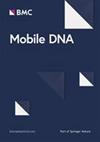透明滑膜炎细胞I型IFN反应中转座元件的转录动力学
IF 4.7
2区 生物学
Q1 GENETICS & HEREDITY
引用次数: 0
摘要
背景蝙蝠是人畜共患病毒的主要宿主,人们对描述蝙蝠先天免疫和炎症的特定特征越来越感兴趣。最近的研究表明,蝙蝠的特异性适应影响干扰素(IFN)信号传导和干扰素刺激基因(ISG),但我们对影响蝙蝠免疫进化的遗传机制的了解仍然有限。在这里,我们使用RNA-seq和CUT&RUN研究了转座子(TE)在小棕蝙蝠(滑鼠)原代胚胎成纤维细胞的I型IFN反应过程中的转录和表观遗传学动力学。结果我们发现多个蝙蝠特异性TE对IFN的反应同时经历基因座特异性和家族水平的转录诱导。我们的转录组重组鉴定了多个ISG,它们从蝙蝠特异性TE中获得了新的外显子,包括NLRC5、SLNF5和IFITM2基因的一种以前未标记的亚型。我们还确定了TE衍生的调节元件的例子,但没有发现强有力的证据支持TE对IFN的全基因组表观遗传学激活。结论总之,我们的研究揭示了IFN在滑膜炎细胞中诱导的许多TE衍生的转录物、蛋白质和替代异构体,突出了可能有助于蝙蝠特异性免疫功能的候选基因座。本文章由计算机程序翻译,如有差异,请以英文原文为准。
Transcriptional dynamics of transposable elements in the type I IFN response in Myotis lucifugus cells
Background Bats are a major reservoir of zoonotic viruses, and there has been growing interest in characterizing bat-specific features of innate immunity and inflammation. Recent studies have revealed bat-specific adaptations affecting interferon (IFN) signaling and IFN-stimulated genes (ISGs), but we still have a limited understanding of the genetic mechanisms that have shaped the evolution of bat immunity. Here we investigated the transcriptional and epigenetic dynamics of transposable elements (TEs) during the type I IFN response in little brown bat ( Myotis lucifugus ) primary embryonic fibroblast cells, using RNA-seq and CUT&RUN. Results We found multiple bat-specific TEs that undergo both locus-specific and family-level transcriptional induction in response to IFN. Our transcriptome reassembly identified multiple ISGs that have acquired novel exons from bat-specific TEs, including NLRC5 , SLNF5 and a previously unannotated isoform of the IFITM2 gene. We also identified examples of TE-derived regulatory elements, but did not find strong evidence supporting genome-wide epigenetic activation of TEs in response to IFN. Conclusion Collectively, our study uncovers numerous TE-derived transcripts, proteins, and alternative isoforms that are induced by IFN in Myotis lucifugus cells, highlighting candidate loci that may contribute to bat-specific immune function.
求助全文
通过发布文献求助,成功后即可免费获取论文全文。
去求助
来源期刊

Mobile DNA
GENETICS & HEREDITY-
CiteScore
8.20
自引率
6.10%
发文量
26
审稿时长
11 weeks
期刊介绍:
Mobile DNA is an online, peer-reviewed, open access journal that publishes articles providing novel insights into DNA rearrangements in all organisms, ranging from transposition and other types of recombination mechanisms to patterns and processes of mobile element and host genome evolution. In addition, the journal will consider articles on the utility of mobile genetic elements in biotechnological methods and protocols.
 求助内容:
求助内容: 应助结果提醒方式:
应助结果提醒方式:


